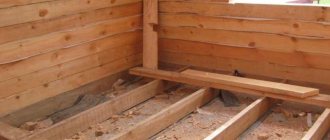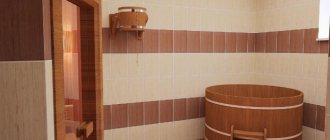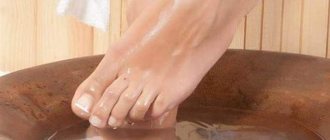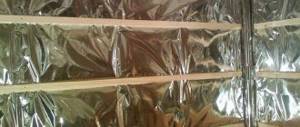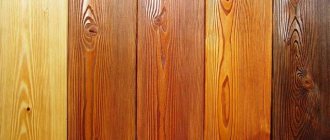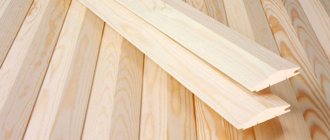The bathhouse, being a place with high humidity, is the most vulnerable and needs protection. True, with big reservations, because protective antiseptics are poisons, the use of which in a bathhouse is undesirable. But compromises are possible here too.
Below we will analyze the types and uses of antiseptics for baths and saunas, and also conduct our own research on which antiseptic for a bath is better to use inside and which outside.
Types of bath antiseptics by purpose
First you need to find out what threats to the tree may arise during its construction operation. It can rot and be attacked by insects and rodents. This limits possible harm from wildlife. Of course, wood can also burn, but here we will not touch on protecting it from fire.
Let's start with rotting. The tree itself consists of compounds that would be very difficult to decompose on their own. Therefore, nature helps forests by providing saprophytic organisms. These are fungi and bacteria that process dead wood. In addition, there are fungi that can settle on living trees - these are xylotrophs.
Rotting is the process of destruction of wood by fungi (and, partly, bacteria). But there are fungi that do not destroy wood, but are harmful to humans - these are molds. The third, least harmful type of fungi associated with wood are staining fungi, such as blue fungi.
IMPORTANT! Antiseptics that fight fungi are called fungicides. But we have listed three varieties of harmful mushrooms. And there is no fungicide that is universal against them all. Moreover, even in a separate category, a fungicide substance may be powerless against something. Complex formulations work best. It is better to check their purpose with the seller or even the manufacturer.
Antiseptics for baths intended to combat wood-boring insects are usually specially labeled, for example, “Anti-Bug.” The correct name for such antiseptics is insecticides.
Well, it’s unlikely that poisons for rats and other rodents should be called “antiseptics”; they are classified in a separate category.
The next important distinction must be made regarding the time of use of antiseptics - whether this is done preventively (preventatively), for prophylactic purposes, or when the pest has already actively manifested itself.
From our point of view, the preventive There is little information about what actually happens. Universal compounds have not yet been invented (more precisely, those that really kill everything are extremely harmful for humans too), and the rest have specifics that there is simply nowhere to find out about. The composition is rarely written on the label. We only met him on very expensive products.
Antiseptic 2.7 l. Saunasuoya soup for protection against moisture and dirt. Banka Photos
Often, preventive wood protection products are included in paint and varnish coatings, in particular primers for glazes and other coatings. This looks like a reasonable measure, but for some reason no one specifies what types of fungi this or that antiseptic fights.
It is not possible to correct this situation. We were able to more or less reliably find out the compositions and areas of application for antiseptic fungicides used as industrial impregnations - we are talking about the so-called “impregnated wood”. In this article you will find a list of the classes of substances and who they are most effective against.
But don’t be fooled – on the impregnated wood market you will only find “Tanalit” and “Senezh”, and in exceptional cases something else.
As for preventive antiseptics for self-application, there is no clarity here. All that remains is to rely on the manufacturer, whose task was to provide protection against the most common types of fungi.
In this sense, we never cease to be surprised that on any jar of antiseptic you can read that its contents have an antimicrobial effect. Here the manufacturer himself is confusing something - we humans are afraid of germs. And wood needs protection from fungi. And ordinary bleach, ethyl alcohol, and hydrogen peroxide are quite capable of killing microbes that are harmful to us. Well, you can hang a bactericidal lamp if you really want to get rid of them. But what do wood processing products have to do with it???
IMPORTANT! In general, it is necessary to oblige manufacturers to write the composition and write against what kind of living creatures this composition works. Because now you are buying something unknown and with an unpredictable effect.
Those antiseptics that are designed to combat an already manifested pest are much more precise in their action. If you need to get rid of blue stains, they will sell you bleach. If it is for mold , use some preparation based on boron compounds. If from rot... We suspect that most likely they will sell you some kind of metal-azole complex, and the metal there will be copper. It’s just that triazoles and metal-azole complexes are most common; they are effective, but not against all types of rot.
If you think about it, a possible solution for prevention is to buy antiseptics to combat an already manifested problem, and apply them in advance. At least you will be sure that you did not waste your money and time.
BY THE WAY! For those who are interested in what they are dealing with, we recommend the book “Wood Rot, Its Causes and Control Measures.” Develop, an informed buyer will eventually force the market to take greater responsibility for products!
It should also be mentioned that antiseptics for a sauna or bath will be divided into internal and external, as well as water-soluble and organic-based (insoluble in water). But more on this below.
The importance of tree protection
Any log structure must be covered with additional protection from the harmful effects of moisture, high temperature and steam inside, and from pests, snow, and rain outside.
External bath treatment products
In specialized stores, impregnations with a special composition suitable for wood processing are available for purchase.
Antiseptic
In order to treat the outside of a timber bathhouse, buy antiseptic compounds. They are designed to protect wood from fungus, moisture and mold. Deformation of wood begins when moisture entering the material lingers there for a long time.
Fire fighting equipment
The next stage of treating the outside of the bathhouse will be coating it with fire-fighting substances. For this purpose, fire retardants are used, which can be used to treat internal walls and facades. Fire retardants have a non-flammable composition and penetrate deep into the wood.
Complex impregnations
There are also complex impregnations that immediately protect against fire and against mold and mildew. They can be used to cover walls inside and outside.
How to antisepticize outside
For external protection , you can use the strongest means without worrying that they may affect your health. Firstly, if they are certified, then they meet modern requirements for the hazard class for people, and they have become significantly stricter since the beginning of the century. Secondly, external use in any case reduces contact with the evaporating (everything evaporates, just at different rates) antiseptic.
So, an antiseptic for a bath outside can be either industrially applied or independently. Water-soluble or organic-based (i.e., washable or non-washable). As part of the soil or independently.
Prosept Eco Ultra antiseptic is non-washable. Photo City of Masters
The use of such a composition outside is limited to the façade and structural details.
What to give preference to? Industrial processing is deeper than self-processing, so it is better to choose an antiseptic for a bath, which is pumped into wood under high pressure in an autoclave.
If this is not possible, then apply it yourself, choosing non-washable compounds for the facade and hidden parts (joists, beams, etc.) - oil-based, organic solvent-based. After application, do not forget to cover it all with a protective layer of varnish or paint.
ADVICE! Even those who have chosen impregnated wood should cover it with a layer of varnish, preferably with a UV filter - this will protect the wood from environmental influences (not only fungi spoil the wood, but also water freezing in the pores, tearing it apart).
Even more details about all types of coatings used in bathhouses outside can be found here.
Types of protective compounds and requirements for them
It should be noted right away that after treating the walls with a protective composition, the appearance of the building should not deteriorate. It is important that the wood retains its natural appeal. The protective layer should not negatively affect the technical characteristics of the wood - air permeability should remain at the same level.
Also, the protective layer must ensure that the wood can withstand atmospheric influences (precipitation, sunlight, temperature changes), fire and insect pests.
Treatment with impregnations allows you to reveal and emphasize the wood grain
All these issues cannot be solved only by treating the walls with antiseptic compounds. Only comprehensive treatment will help. Using the following means:
- Antiseptics that prevent the appearance of mold and mildew.
- Antiperenes , which increase the fire resistance of wood. During processing, the substance penetrates the top layer of wood and is released when the surface is heated, forming a protective film.
- With the help of varnishes and paints, wood can be protected from atmospheric moisture and sun. To preserve the wood texture and shade, it is recommended to use colorless compounds. Sometimes a colored pigment can be added to enhance the tone of the wood.
Expert opinion: Masalsky A.V.
Editor of the “construction” category on the Stroyday.ru portal. Specialist in engineering systems and drainage.
To ensure that the treatment is carried out evenly and there are no missed areas, tinted fire retardants and antiseptics are used. There are also colorless compositions that can be tinted if necessary.
The use of protective compounds and coatings allows you to preserve a wooden frame in its original form and extend the service life of structures. There is no other way to preserve the shade and texture of wood. Painting with alkyd compounds and varnishing is only a temporary measure. At the same time, the “breathing” ability of wood with repeated staining is significantly reduced.
The treatment of bath walls is carried out in stages:
- First, the walls need to be prepared - clean and sand the outer layer. At this stage, the damaged wood is removed, the surface becomes smooth - this will allow the impregnation to be applied evenly and ensure its maximum penetration into the structure of the material.
- Then the walls are completely treated with protective compounds several times. Each layer is applied after the previous one has completely dried.
- The last layer is designed to protect the wood from external influences (paint, varnish, stain).
Initially, the logs from which the bathhouse will be built are treated with protective compounds - antiseptics. When the log dries to the optimal moisture content, substances are applied to its ends that prevent deformation and cracking of the natural building material.
Primary processing is carried out at the stage of assembly of the structure
It is a mistake to think that this processing is sufficient. Indeed, during the construction process, logs or beams are subject to adjustment and trimming, so the finished structure also needs careful processing.
Note! The surface of the log house is processed several times. First, immediately after shrinkage. Then after two or three years. The next time occurs after four to five years, when the effect of the protective impregnations weakens.
But these are only theoretical recommendations. In fact, the protective layer weakens much faster and this depends on the climatic characteristics of the construction region.
How to antisepticize inside
The antiseptic for wood in the bathhouse inside differs from the outside only in less aggressiveness. The substances themselves will be the same, but they will be dissolved in water and therefore fundamentally washed out. The latter means the need for periodic updating.
Treating the bathhouse with an antiseptic inside can be done freely in all rooms except the steam room. Only in a steam room can high temperature affect the retention of the product in the thickness of the wood - most likely the antiseptic will evaporate, getting into the lungs of the steamers.
You can find more information about interior coatings at this link.
Which is better for floors, ceilings, walls
Wherever wood is used, in principle, it would be worth using an antiseptic. Fungal spores are constantly floating in the air, they are just waiting for the right conditions to germinate. Our task is not to create such conditions for them. Including making the wood inedible or at least simply tasteless to them.
What is the difference between an antiseptic for the floor in a bathhouse, for its walls and ceiling? In principle, except that the floor of all of the above will be the coldest and most distant from our respiratory organs.
You need to understand that it is the increase in temperature that makes volatile substances volatile - look in the refrigerator, cold borscht smells much weaker than heated one, because the smell comes from heated and separated particles. It’s the same with an antiseptic - where it’s colder, you can worry less about evaporation.
Antiseptic Zelest A-3 Standard 10 kg, suitable for interior and exterior work. Photo Pilomaterialy.rf
Well, the floor is, after all, a place that suffers more from water in a bathhouse than the same ceiling. Therefore, it needs somewhat more protection.
What do you recommend? We have already said that the best wood is that which has been antisepticized industrially. But this is best used for beams and joists, as well as for subfloors. To clean the floor, you can treat the inside of the bathhouse with an antiseptic, which is included in the primer for varnish or paint.
ATTENTION! You can forget the rule regarding the floor in the steam room, because it is quite normal practice for the floors to be covered with the same yacht varnish, which is not afraid of frequent interaction with water. Before coating with this varnish, you can use an antiseptic, which is intended for the inside of a bathhouse.
However, you can get a complete picture of acceptable floor coverings from this article on our website. And here is material for those who are interested in learning more about floorboards.
The walls and ceiling can be treated in the same way, but avoiding the steam room. Still, do not forget that the antiseptic layer anywhere is intermediate between wood and varnish/paint. At the very least, it is highly desirable that it be intermediate.
Read about how to treat boards used for interior cladding here.
Additional properties of antiseptics
Manufacturers assign additional functions to some formulations. These include:
- Fire protection. The components included in the antiseptic for saunas help inhibit the combustion process, as they form a film that does not allow oxygen to pass through. This is why the flame cannot spread and the combustion process stops.
- Moisture resistance. To prevent wood from starting to deteriorate due to constant exposure to moisture, it is necessary to use antiseptics that protect the wood from the inside and have additives that prevent the development of fungus. Places near the foundation, as well as under the roof, need to be treated with such solutions. When choosing moisture-resistant compounds, it should be remembered that for internal treatment of premises it is necessary to choose hypoallergenic substances. The antiseptic “Neomid 200” has this property.
- Surface whitening. If wood is exposed to mold and woodworms, its color may change. That is why antiseptics are created that have the function of bleaching the material. They not only disinfect the wood, but also restore its natural color.
- Frost resistance. If the bathhouse was built in a region with harsh climatic conditions, for external treatment it is necessary to choose compounds that are more resistant to low temperatures. Such solutions help to increase the service life of the structure.
- Decoration. Impregnations for saunas have different shades, thanks to which you can highlight the structure of the wood and make the structure more attractive.
By evaluating the selected composition according to all the described characteristics, you can find exactly the one that is suitable for your bath. Most often, sauna owners purchase Neomid 200 for internal treatment.
Wood processing inside the steam room and washing room
Let's start with the washing room. There is more water there and the temperature is lower than in the steam room. It would definitely be worth recommending an antiseptic. If there is no desire to cover everything with it except the benches - at least the floor and the perimeter half a meter high - water accumulates below, you need to make an effort to dry everything, and without this, rotting becomes more likely. Any suitable antiseptic for treating the inside of a bathhouse can be used to protect the washing area.
In a steam room, in our opinion, you can safely treat the floors and perimeter with an antiseptic at a low height. But only subject to subsequent treatment with either some water-based varnish for a steam room, or oil-based water-repellent impregnation Let us remind you that only washable antiseptics are used inside.
Water antiseptic for baths and saunas Neomid 200 Proff 1 l. suitable for washing. Photo by Leroy Merlin
In addition to the above, you can also safely use regular chlorine bleach or commercial chlorine-based antiseptics. Their main purpose is to combat staining fungi, but they can also be used for routine disinfection and bleaching of the darkened top layer of wood. You can simply sand darkened wood.
Usually in the steam room they try not to use any chemicals at all, and fight rot... with good ventilation, additional heating after drying procedures, rubber gaskets for the legs of the shelves, gaps between the floor and the lining. If nothing helps, and rot or mold still appears... Well, then you just need to replace the damaged one with a new one. In other words, the use of an antiseptic in a steam bath depends solely on your ideas about its harms and benefits.
Additionally, we recommend that you read the material in which we talk about impregnations for shelves.
Which one is good for a log house, and which one is good for lining
How does a log house differ from a lining? Thickness of wood. Therefore, the first thing to keep in mind is how deep the antiseptic will penetrate. Sufficient depth is achieved only with industrial impregnation. But does it make sense to build a bathhouse from impregnated logs? Of course not.
But the lower crowns, for example, would be very worth making from just such logs. Because they are the ones that usually rot, even from larch. It is enough to make only the very bottom crown with this impregnation.
Another standard place for decay is window sill timber. If desired, it would also be worth making it from treated logs.
The rest of the log house is processed as follows: everywhere on the outside, inside - everywhere except for the steam room. The processing of the log itself is not mandatory. It's all up to you. In this case, as an antiseptic for a log bathhouse, those compounds are used that are intended for self-application.
Antiseptic BATH THINGS for baths and saunas, for external and internal work. Stroylandia Photos
Read more about timber and methods of processing it in this article.
As for the lining (! about linden lining in detail in a separate article), you need to distinguish where it is located - facade lining can be freely processed with everything that is intended for external processing, but about the internal one it’s worth thinking about again, because this material is easy It is replaceable, and due to its small thickness it is easy to dry.
Therefore, it is advisable to impregnate the lining in the bathhouse with an antiseptic only in the most vulnerable - this is the junction of the floor with the wall, corners that are poorly ventilated, and the legs of the shelves that get wet during the procedures. The rest of the space can be impregnated with oil or oil wax, which protect the wood from moisture saturation, thereby indirectly helping to protect against fungi - their mycelium develops successfully only in very moist and oxygenated wood.
More information about how you can process lining is here.
Why do you need an antiseptic?
Wood is the most common material from which baths are created. But it is subject to the influence of many negative factors and with prolonged use it loses its original appearance and begins to deteriorate. Deterioration is accelerated by high humidity levels.
The solution to the problems described is the use of Neomid 200 antiseptic for saunas and baths. To properly apply the composition to wood, you must carefully study the instructions that are on the packaging of the purchased product. When purchasing, it is worth remembering that some products are created for external use, while others are for internal use. If you choose the wrong antiseptic, it will be less effective.
The described compositions for saunas and baths are usually sold in the form of solutions or ointments. Many of them contain substances that reduce the likelihood of wood fire. It is worth remembering that some impregnations act selectively. For example, such compositions can protect against fungus, but do not prevent the appearance of mold. It is worth choosing compounds that completely protect the wood from the effects of adverse factors.
Before use, you need to remember that many compounds change the appearance of the tree. but in most cases this does not affect the appearance of the walls of the bathhouse.
For baths and saunas: which one is better to choose?
It is difficult nowadays to choose a good antiseptic for a bath. And mainly because you have to buy something with an unknown composition and scope. You have to focus solely on what the manufacturer wrote on the label. And this is more advertising than reference information. We analyzed what the manufacturers say and provided their statements with our own comments.
Now about the types of baths. Russian and Finnish should be distinguished according to two criteria - humidity and heat. water-soluble, that is, washable, can be used indoors . It is not difficult to draw conclusions from this.
Finnish version
A sauna is a very hot place and very well ventilated, but there is little water in it ( 5-15% during procedures). Therefore, the main requirement for an antiseptic for a sauna is that it must remain inside the wood at the operating temperatures of this bath. To prevent it from evaporating and decomposing, it is covered with a layer of varnish.
Antiseptic Prosept Sauna for baths and saunas concentrate 1:10 colorless 1 l. Photo Petrovich
All these technologies are best developed in the homeland of the sauna - in Finland. Since there are strict safety requirements , you can safely take what is produced by well-known companies in this country. And immediately in finished form - primer and varnish.
Russian variant
The Russian bath acts on the antiseptic not so much with heat as with humidity. Therefore, leaching occurs naturally. Again, this happens if the antiseptic layer is not protected. However, it is worth clarifying that in the bath everything is washed out slowly - the same impregnation with oil must be renewed once a year. So you need to be prepared for the update process.
We believe that all of these steam room varnishes can be used at floor level or slightly higher. High humidity is an aggressive environment for varnishes and paints, so you need to take either yacht varnishes, or paints that can be used in bathrooms , or the same Finnish products that they produce for saunas.
ATTENTION! You may find our guide article on painting a bathhouse useful, in which we consider many specific issues related to the protection of surfaces made of different materials used in a bathhouse.
Tools for applying antiseptic
To apply Neomid 200 antiseptic, you must have the following tools:
- hard brush;
- brush or roller;
- gloves;
- respirator.
After cleaning the surface, it is dried. Then the Neomid composition is applied with a roller or brush so that it spreads evenly over the surface. After the impregnation has dried, the surface is covered with a second layer. It is worth remembering that preparing walls for applying Neomid antiseptic for saunas should be done immediately after construction of the structure.
The best (or rather, famous) compositions
Now let's figure out what the market offers.
IMPORTANT! We went through the official websites of the manufacturers, and their lack of information about the composition is not at all in their favor.
The most important thing: keep in mind that you have to start from what is on the market, so it turns out that there are not so much “the best antiseptics for a bath”, but rather those that are well-known . There are indeed many manufacturers, but most of them are completely unknown and the composition is hidden, so it turns out to be a “pig in a poke”; there is no point in writing about them.
Let's start with the Finns. Our little research showed that it is only possible to buy a Finnish antiseptic for a sauna in the form of a primer for their own paint and varnish products for the sauna. In general, of course, it is more convenient to talk about companies; they usually produce several antiseptics for our purposes with a rather vague description of what they work against.
Tikkurila
Offers "protective acrylate compounds" such as Supi Arctic or Supi Saunasuoja . The annotation says that it contains an antiseptic component that protects (attention!) from mold. No other mushrooms are mentioned. Both products are aqueous solutions of acrylic dyes, which are truly safe for health. Both are intended exclusively for use in a Russian or Finnish steam bath.
Tikkurila Supi Saunavaha antiseptic for baths and saunas, colorless 0.9 l. Photo Petrovich
In addition, the company produces antiseptics for facades and interiors of residential premises. For example, Homeenpoisto is ordinary bleach, as in “Whiteness” (sodium hypochlorite solution). Used to combat mold or blue stains that have already developed. By the way, you can also use it in a steam room. For facades – Euro Eko Wood . This is a glazing antiseptic that fights fungi, mold and blue stains. I am glad that here they distinguish wood-destroying fungi from molds. The timber can be protected with Vinha covering antiseptic, but only against mold.
Teknos
Here you will find primer versions of antiseptics. For example, Woodex Aqua Base or Teknol Aqua 1410-01 are water-soluble, and there are also “penetrating” ones based on organic solvents (we said that this is only for facades) - these are Woodex Base and “Java”.
An advertisement from the manufacturer stated that the company's primer antiseptics fight all three types of fungi - staining, mold and rotting. What is most pleasing, of course, is that the same composition (!) in different concentrations fights both the first two and wood-destroying agents. Fantastic!
"Senezh"
“Senezh-Bio” also saves you from all types of mushrooms with one composition, plus it is also effective against insects. The manufacturer recommends using it indoors and outdoors, in residential and commercial buildings, claiming that the product is strong but safe for people and animals. The composition (like the Finns) is not indicated. From this category of “preservative antiseptics” there is also simply “Senezh”, “Senezh-Ultra” and “Senezh-Impra” . The latter is generally intended for impregnating wood, that is, it is powerful, but it is unlikely to be as effective when applied superficially... with a roller or brush.
Preservative antiseptic SENEZH 10 kg. Stroylandia Photos
“Senezh-Sauna” is even cooler. Fights all(!) types of fungi, as well as insects and... algae. Manufacturers have not forgotten about microbes - Senezh-Sauna also destroys them. Looks like some kind of ultimate weapon. At the same time, it is an analogue of Tikkurila products - this is also a water-based acrylate composition.
"Senezh-Insa" is an antiseptic mainly for fighting insects.
“Senezh-Tor” behaves best when protecting the ends of logs and beams.
"Senezh-Eurotrans" is an antiseptic that only fights blue stains and mold, and mainly when transporting logs and lumber.
"Senezh-Effo" - mainly as a bleach.
GOODHIM
An antiseptic is a ready-to-use aqueous solution intended for interior work. Antiseptic for baths and saunas has a high antibacterial effect, destroys pathogens of infectious diseases, and is used to protect wooden surfaces from the effects of insects, fungi and algae.
Sold in plastic containers with a capacity of 0.5 and 5 liters, the solution can withstand temperature changes and high humidity, does not change the color and appearance of wood products, and does not affect their characteristics, such as strength, adhesiveness and paintability. You can buy through the manufacturer's website.
Neomid
Antiseptic for baths and saunas NEOMID 200, 0.5 l., concentrate. Photo by Maxidom
The most popular brand of antiseptic for baths is Neomid 200 . This is truly a universal remedy. If the Finns somehow distinguish the products that can be used to cover shelves from the products for everything else, then here everything can be processed without exception.
What worries us personally is that it itself, that is, it turns out that mold is responsible for everything and besides it, no one else from mushrooms stains or destroys wood? Since this is not true, the question arises: what does Neomid 200 actually fight against ? We would venture to guess that it is moldy and blue. As for rot, we’re not sure. The composition is described indirectly: “a synergistic mixture of biocides” – this means nothing at all.
For baths, Neomid also offers a special oil - “wood-protective for baths and saunas.” Again, it’s amazing - this oil protects against fungi and at the same time it can be applied to shelves (! Linden shelves require special attention), it is so harmless to humans.
"Neomid 100" is an insecticide aimed strictly against woodworms.
"Neomid 500" - bleach.
A series of hard-to-wash and generally non-washable antiseptics - “Neomid Eco”: Neomid Exra Eco, Neomid Base Eco, Neomid 440 Eco , etc. This is suitable for external protection.
"North"
"Pirilax-Prime" - fire and bioprotection. We did not consider all products of this class; they are widely represented by both Senezh and Neomid. But since Pirilax is in demand, we decided to mention it. Used as a primer under paintwork materials. Protects against mold, blue stains, fire and insects.
“Nortex-Doctor” is suitable not only for wood, but also for concrete , and the range of biocidal effectiveness includes not only mold, but also wood-destroying fungi and wood-boring insects. The manufacturer is confident that its products can be used in baths. The technical specifications say that it complies with GOST against mold and wood-staining fungi. Therefore, it is unlikely to be effective against rot.
"Nortex-Disinfector" is a stronger version of the previous antiseptic. The main purpose is to fight mold, in addition - against blue stains, algae, beetles - on wood, stone, brick, and what is even more remarkable - inside and outside. The composition is, as usual, not specified.
RESULTS! In general, there are no products on the market with a clear composition that are effective primarily against house rot, but there is something that guarantees effectiveness against mold and blue stains, beetles and algae. Any of the above will be a good antiseptic for a bathhouse inside, if the task before it is not beyond its capabilities.
Basic rules for bath treatment
- To ensure uniform distribution of the composition over the entire area, and therefore reduce its consumption per m², the base should be cleaned. Even better is to sand the timber. If a certain defect is identified, the wood is removed from the entire affected area.
- Treatment begins with impregnation with an antiseptic composition. And at least 2 times (depending on the condition of the bath), with a break for complete drying of the applied layer. Extreme care and attention should be paid to the ends of the timber, the joints of the samples and the corners of the structure.
- After antiseptics, fire bioprotection agents (or “pure fire retardants”) are used.
- The final stage is treating the timber with the selected paint and varnish composition.
Useful tips
Preparations for processing timber should be purchased at specialized retail outlets. Various flea markets and street stalls are not an option. It is in such places that cheap fakes are mainly sold, which will not provide reliable protection for the wood of the bathhouse.
When choosing any product, you need to pay attention to the depth of its penetration into the material. The higher this indicator, the better.
One of the enemies of wood is ultraviolet radiation. By the way, as practice shows, few people think about this. But the sun's rays destroy this material no worse than biological pests and moisture, although this is expressed somewhat differently. The appearance of cracks, cracks, and twisting of timber is the basis for unscheduled repairs of the bathhouse. And this, taking into account the specifics of the construction of a log house, is quite an expensive undertaking.
For internal treatment of the bath, you should purchase products that do not contain “chemicals”. Otherwise, harmful discharge (and there will definitely be some, at least from high temperature) is inevitable. As an example, a wax composition for treating a timber bathhouse from the inside “Teknowax 1160” , acrylic varnish “Teknocoat Aqua 2550” .
External treatment of the bath can be done with Aquatop 2920-04 . This is a varnish that forms a thin transparent film on the timber.
The article provides examples of compositions that are used when processing timber inside and outside the bathhouse. But they are not the only ones. It is easy to find a good alternative to these drugs in a specialty store if they are out of stock.
Source: dearhouse.ru
Processing inside: how to process - methods and technologies
How to treat a bathhouse with an antiseptic? There are three methods (minimum) suitable for these purposes. They will differ in the depth of impregnation. Well, let’s describe the fourth, the best, but requiring industrial equipment.
The simplest and most accessible method for everyone is to apply the solution to the surface of the wood using a roller or brush, or if you have one, use a spray bottle. This is done several times as the previous layer dries. The number of layers is usually specified by the manufacturer in the instructions. The penetration depth of the antiseptic is minimal - up to 5 mm, but more often 2-3.
Antiseptic (impregnated) edged board, pine. Photo Pilomaterialy.rf
The second method gives a slightly greater depth of impregnation and at the same time requires some equipment. For prepared (cleaned to wood) lumber, a “bath” is made - for example, it can be dug in the ground in the form of a trench of the required length and covered with polyethylene.
An antiseptic solution is poured into the bath, and the lumber is completely immersed in it for several days. The number of days depends partly on the type of wood. Let's say that spruce always needs more time to soak than pine.
The third method can also somehow be implemented on the site. To impregnate boards, for example, sand is soaked in antiseptic, and then stacks of prepared boards are layered with this sand. The stack of sand is covered with films and left for a couple of weeks. It is assumed that the film will protect the antiseptic from evaporation, and the wood will absorb it through osmosis.
The fourth method is beyond the capabilities of the owner of the site (for independent implementation). is already needed here . This is an industrial impregnation, which is called impregnation. The deepest, most effective. Lumber impregnated with a suitable antiseptic is sold everywhere, they are green or brown, a good manufacturer uses a product from Britain called “Tanalit” - it does not work only against one class of house rot - basidiomycetes, it resists everything else well.
Application and precautions
Before use, con must be diluted with water in a ratio of 1:30. Application to the material occurs using a brush or roller. During this process, it is necessary to ensure that the solution is evenly distributed over the surface of the bath walls.
The consumption of the Neomid 200 solution is approximately 150 grams per square meter of bathhouse walls. The antiseptic must be applied at a temperature not lower than +5 degrees. After the wood has been treated with neomid, it must be protected from precipitation and water until it dries completely. Depending on the conditions of use of the premises, re-treatment may be required after 5-8 years.
Precautionary measures:
- When applying the composition, it is necessary to use protective equipment such as gloves and goggles;
- if the antiseptic gets on the skin, it must be washed with plenty of water;
Useful video
The video below advertises “Neomid 200”:
But Tikkurila made a commercial that talks about what affects wood and how to deal with it - from products to application technology:
***
Have you ever used any antiseptic in your bath? If yes, share your experience and impressions in the comments.
By the way, there is still a lot of interesting things on our website. For those who would like to keep abreast of updates, we recommend subscribing to our channel on Telegram.
Important points
Some of the volatile components in the composition of impregnations can cause real harm to health, so they cannot be used in a steam room.
If necessary, you can carry out disinfection in a bathhouse with your own hands. However, many experts do not recommend using synthetic compounds for these purposes. Why? The temperature in the sink and steam room is often very high. It provokes the evaporation of antiseptic components from the surface of the floor or wall that has been treated with it. Some of the volatile components can cause real harm to health.
To prevent the negative effects of anti-putrefactive agents on the body, the choice of protective compounds must be approached with care:
- In the rest room and dressing room, the air temperature, as a rule, does not exceed 27 degrees. They can be used without problems with synthetic compounds;
- In the sink and steam room both humidity and temperature are high. To eliminate the possibility of volatile substances entering the body, it is better to treat logs, floor boards and other wooden elements with organic-based compounds.
Classification of protective equipment
To correctly select an antiseptic drug, it is important to have an idea of their types.
There are several types of antiseptics:
- Easily washable. Such impregnations contain metal salts, which are gradually washed out under the influence of moisture. Such impregnations are best suited for dressing rooms and rest rooms, but not for steam rooms.
- Difficult to wash out. These impregnations contain natural and synthetic oils. Suitable for external processing of log houses.
- Short action. Such impregnations are quickly absorbed and are best adapted to high humidity and high temperatures. In addition to mold, short-acting impregnations protect against rot and bark beetles.
Some impregnations are available in a colorless version, but most formulations contain pigments that give the material a given shade. The use of bright impregnations makes the work easier, since the treated areas become visible and there is less chance of missing some area.
The advantage of colorless antiseptics is the preservation of the natural color of the wood. At the same time, it is recommended to work on such wood with a brush rather than a sprayer, since in this case it is easier to control the areas of the work done.
Laying tiles on the floor in a bathhouse
In modern baths, you can increasingly find tiles on the floor. And not only in the relaxation room and washing room, but also in the steam room. Tile is a universal finishing material. It is not afraid of temperature changes and water; the tiles are easy to care for and can be regularly treated with disinfectants. It doesn't rot or burn. And the variety of shades, patterns, shapes and sizes allows you to realize any design idea. In addition, tiles go well with natural wood.
Gratings over ceramic tile floors
Tiles for laying on the floor of a bathhouse have the following advantages:
- This is an environmentally friendly material made from natural ingredients that does not emit harmful substances or smell.
- The tiles are absolutely not afraid of water, in any quantity. Its structure ensures minimal hygroscopicity.
- The tiles are easy to care for and do not absorb odors or dirt.
- The tiles are not afraid of temperature changes, hot steam, or condensation.
- The material does not rot and is not destroyed by insect pests.
- It can imitate any materials and is available in a wide range of colors, shapes and sizes.
- The tiles are compatible with underfloor heating systems. In a bathhouse, especially in a washing room and steam room, to ensure tactile comfort, it would be a good idea to organize a water-heated floor powered by a stove.
- When laying tiles, it is not difficult to make the necessary slope to drain water into the drain hole.
Preparation and styling
The base for laying tiles can be wooden or concrete. The second option is more preferable. The concrete floor is also moisture resistant and does not rot. Before pouring the screed, it is necessary to install a drainage system and a drainage system. It is better to locate the drain hole in an area with less traffic. The material of the drain hole located on the floor surface should not overheat under the influence of high temperatures.
When the concrete base gains strength, tiles can be laid. The process occurs in the same way as in residential premises. However, on the floor in the bathhouse it is necessary to provide a slope towards the drain. The process of laying tiles is as follows.
Table. Instructions for laying tiles
| Illustration | Description |
| Step 1 | The concrete base is checked for evenness - it should not have defects on its surface. It is immediately worth noting that the slope can be formed by a screed or during installation using an adhesive solution. The concrete is cleaned of dust and degreased. Then the markings are applied, using as a sample the laying diagram previously drawn on a piece of paper to scale. The trimmed tile elements should be in invisible areas (in corners, under shelves). |
| Step 2 | Tiles are laid along the first marking line. Spacer plastic crosses are immediately placed between the tiles. This will allow you to draw a second marking line, which will run at an angle of 90 degrees to the first. Laying the tiles will begin from the intersection point. |
| Step 3 | Prepare an adhesive solution. The adhesive for laying tiles in a bathhouse must be elastic, since it will regularly be exposed to temperature changes. Instructions for preparing the adhesive composition are indicated by the manufacturer on the packaging. It is produced in the form of a dry mixture, which must be diluted in a certain proportion with water and mixed until smooth using a construction mixer. |
| Step 4 | The finished solution is applied to the area where the first tile is laid, slightly extending beyond the boundaries of the marking. Level the composition with a notched trowel. |
| Step 5 | When laying large-format tiles with one side larger than 300 mm, the adhesive composition is applied to the back side. Laying large tiles is preferable, since the coating ultimately has fewer seams. |
| Step 6 | The tile is laid, checking its position in the plane. The quality of the subsequent floor covering depends on the correct installation of the first element. |
| Step 7 | To adjust the position of the tile, tap it with a rubber hammer. This must be done through a layer of thick cardboard or thin plywood so as not to damage the material. |
| Step 8 | During the process of laying the tiles, a joint is formed between the tiles using plastic spacer crosses. |
| Step 9 | A day later, when the glue has dried, the crosses are removed and the joints are grouted. The grout can be epoxy or cement. The first one requires skill, as it picks up quickly. The grout is spread over the seams using a grater. Then (after 10 minutes) the excess is removed with a damp sponge. After 40-50 minutes, wipe the tiles. If there is a white coating, then a special product is used to remove it. |
If porcelain stoneware is used as a floor covering, then special attention should be paid to the adhesive solution, which should have not only high elasticity, but also adhesion.
